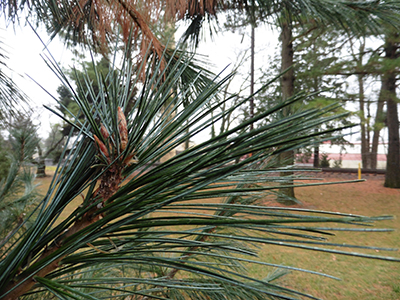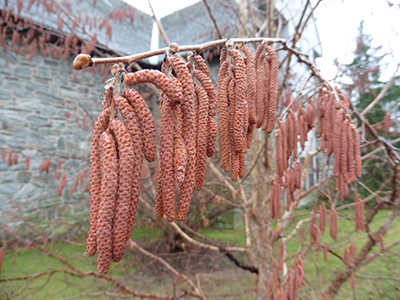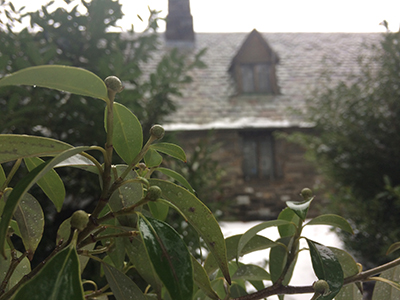
Plants of the Week: February 11

Pinus flexilis ‘Cesarini Blue’
Close to the train tracks on the southern side of campus, tucked away in the Pinetum, is a young specimen of Pinus flexilis ‘Cesarini Blue’, the “limber pine.” It stands with a curving, loose form sprawling about ten feet wide with long, drooping needles. Sources indicate that the species hails from the Rocky Mountain region of the Western United States, reaching heights of sixty feet in the wild. The cultivar ‘Cesarini Blue’ boasts a true blue needle; in actuality the needles are glaucous blue with long white stripes. P. flexilis is a nice specimen to make a statement in a spot where it can stretch out expressing its graceful but somewhat gangly nature. photo credit: J. Bickel

Corylus fargesii
Among the many drab colors this time of year, the Farges’ Filbert Corylus fargesii is a welcome splash of peachy, salmon-brown and is rife with dangling, tawny catkins. A member of the birch family Betulaceae, the bark peels like river birch, yet has many more shades of tan. Generally considered a “medium” tree, C. fargesii can reach heights of 20 to 30 feet offering shade in the summer and strong garden interest in the winter. Originally from China, it is a strong ornamental with a wide tolerance of soil-site conditions for growing, even handling part shade and full sun situations. One, if not the only specimen of Corylus fargesii on Swarthmore College campus, is tucked in close to the North side of Mertz residence hall. photo credit: J. Bickel

Cornus elliptica ‘Elsbry’ [sold as Empress of China™]
An oddity in limited company among the dogwood family Cornaceae, C. elliptica is a medium-sized, broadleaf evergreen tree. Featuring small, waxy, nearly lanceolate leaves that can turn red in the winter, this tree flowers in early June and produces fruits that resemble those of Cornus kousa. Hardy to zone 6 and native to China, Cornus elliptica is “must have” for collectors of oddities and unique plants. Preferring shade conditions, a young, healthy specimen of this resides in the Camellia collection tucked away neatly on the west side of Bond Hall near Chester Road. photo credit: J. Bickel





Wendy Coolen
Posted at 09:19h, 15 FebruaryWow, very, very interesting plants. Your college must be so inedible to visit. I am really enjoying learning about all of the different species and varieties, still learning new things after 35 years as a gardener!! One request, would;d you be able to include photos of the whole plant specimen as well as a close-up? Would love to see the forms of the trees and shrubs. Love this site!
Becky Robert
Posted at 10:15h, 24 FebruaryThank you for reading our page, Wendy. I will endeavor to provide overall views.
Enjoy winter,
Becky Robert
Scott Arboretum
Marianne Baxter
Posted at 12:25h, 15 FebruaryIt would be nice to have a photo of the whole plant, especially unusual plants suggested as specimens, such as the pine and the corylus. The text mentions the habit and the bark, but the photos don’t show any of that. It’s frustrating….
Becky Robert
Posted at 10:15h, 24 FebruaryThank you for the note Marianne. I will endeavor to include an overall shot.
Sincerely,
Becky Robert
Scott Arboretum